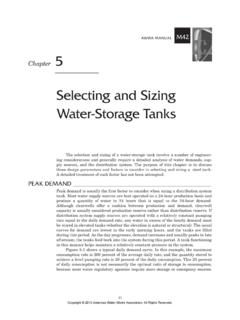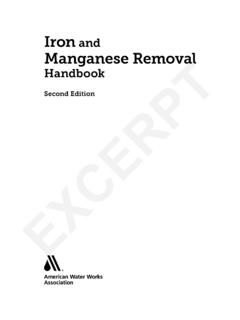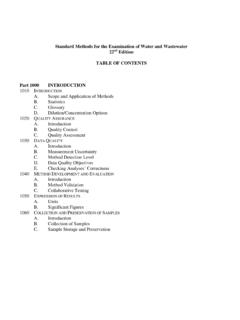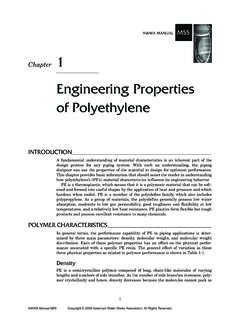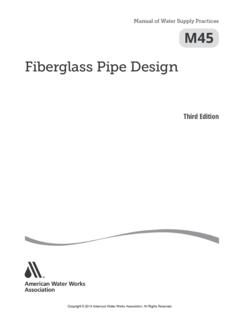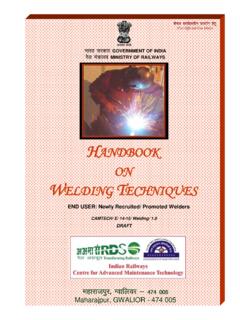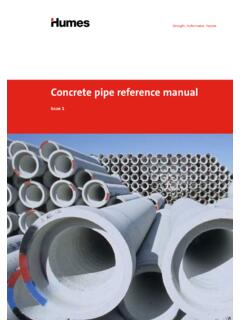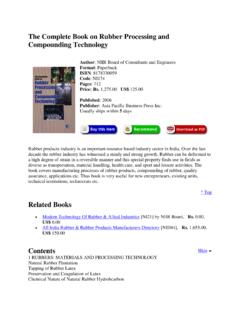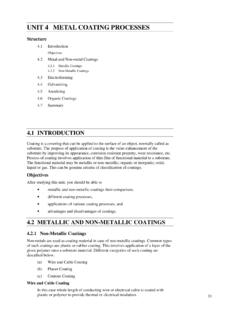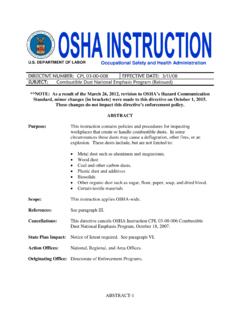Transcription of PVC Pipe—Design and Installation - American Water Works ...
1 PVC Pipe Design and InstallationAWWA MANUAL M23 Second EditionScience and TechnologyAWWA unites the drinking Water community by developing and distributing authoritative scientific and technological knowledge. Through its members, AWWA develops industry standards for products and processes that advance public health and safety. AWWA also provides quality improvement programs for Water and wastewater 2002 American Water Works Association, All Rights ReservedContentsiiiList of Figures, vList of Tables, viiForeword, ixAcknowledgments, xiChapter 1 General Properties of Polyvinyl Chloride , 1 Material Properties of PVC Pipe Compounds, 1 Corrosion, Permeation, and Chemical Resistance, 2 Environmental Effects, 5 Chapter 2 Testing and and Inspection, 9 Chapter 3 Formulas, 13 Chapter 4 Design Factors Related to External Forces and Loads, 21 Flexible Pipe Theory, 24 Longitudinal Bending, 33 Expansion and Contraction, 40 Thrust Restraint General, 42 Chapter 5 Pressure Hydrostatic Pressure, 53 Distribution Mains, 58 Transmission Mains, 59 Injection-Molded PVC Fittings, 62 Fabricated PVC Fittings, 63 Dynamic Surge Pressure.
2 63 Transmission Pipe Design Example, 67 Chapter 6 Receiving, Storage, and , 73 Storage, 75 Chapter 7 , 77 Alignment and Grade, 77 Installation in Trenches, 77 Pipe Joints, 82 Pipe Cutting and Bending, 83 Pipe Embedment, 84 Casings, 86 Copyright 2002 American Water Works Association, All Rights ReservedivAppurtenances, 88 Thrust Restraint, 91 Chapter 8 Testing and Testing, 93 Timing of the Testing, 93 Initial Cleaning of the Pipeline, 94 Test Preparation, 94 Hydrostatic Testing and Leakage Testing, 94 Test Pressure, 95 Duration of Tests, 95 Allowable Leakage, 96 Disinfecting Water Mains, 96 System Maintenance, 96 Chapter 9 Service Tapping, 99 Saddle Tapping, 105 Tapping Sleeve and Valve, 107 Appendix A, Chemical Resistance Tables, 109 Appendix B, Flow Friction Loss Tables, 129 Bibliography, 157 Index, 163 List of AWWA Manuals, 167 Copyright 2002 American Water Works Association, All Rights Reserved 1 AWWA MANUALM23 Chapter1 General Properties of Polyvinyl Chloride PipeB A C K G R O U N D _____Polyvinyl chloride (PVC) was discovered in the late nineteenth century.
3 Scientists atthat time found the new plastic material unusual in that it appeared nearly inert tomost chemicals. However, it was soon discovered that the material was resistant tochange, and it was concluded that the material could not be easily formed or processedinto usable the 1920s, scientific curiosity again brought polyvinyl chloride to public atten-tion. In Europe and America, extended efforts eventually brought PVC plastics to themodern world. Technology, worldwide and particularly in Germany, slowly evolved forthe use of PVC in its unplasticized, rigid form, which today is used in the production ofa great many extruded and molded products. In the mid-1930s, German scientists andengineers developed and produced limited quantities of PVC pipe. Some PVC pipeinstalled at that time continues to provide satisfactory service today.
4 Molecularly ori-ented polyvinyl chloride (PVCO) pressure pipe has been installed in Europe since theearly 1970s and in North America since A T E R I A L P R O P E R T I E S O F P V C P I P E C O M P O U N D S _____Polyvinyl chloride pipe and fabricated fittings derive properties and characteristicsfrom the properties of their raw material components. Essentially, PVC pipe and fabri-cated fittings are manufactured from PVC extrusion compounds. Injection molded fit-tings use slightly different molding compounds. PVCO is manufactured fromconventional PVC extrusion compounds. The following summary of the material prop-erties for these compounds provides a solid foundation for an understanding andappreciation of PVC pipe chloride resin, the basic building block of PVC pipe, is a polymerderived from natural gas or petroleum, salt Water , and air.
5 PVC resin, produced by anyof the common manufacturing processes (bulk, suspension, or emulsion), is combinedCopyright 2002 American Water Works Association, All Rights Reserved 2 PVC PIPE DESIGN AND Installation with heat stabilizers, lubricants, and other ingredients to make PVC compound thatcan be extruded into pipe or molded into and taste-and-odor evaluations of PVC compounds for potable waterconveyance are conducted in accordance with procedures established by NSF Interna-tional.* The extracted Water must not exceed the maximum contaminant levels estab-lished by the US Environmental Protection Agency s (USEPA) National InterimPrimary Drinking Water Regulations (1975) and by the NSF limits of acceptance forresidual vinyl chloride monomer and for taste and odor as shown in Table 1-1 of NSFS tandard 61.
6 Monitoring is conducted by NSF International or approved pipe extrusion compounds must provide acceptable design stress propertiesas determined by long-term testing under hydrostatic pressure. Hydrostatic designstress ratings for pipe compounds are established after 10,000 hr of hydrostatic test-ing. Long-term performance of injection molded PVC fittings compounds are subject toat least 2,000 hr of hydrostatic s PVC pipe and fittings standards define the basic properties of PVC com-pound, using the American Society for Testing and Materials (ASTM) SpecificationD1784, Standard Specification for Rigid Poly (Vinyl Chloride) (PVC) Compounds andChlorinated Poly (Vinyl Chloride) (CPVC) Compounds. The specification includes afive-digit cell class designation system by which PVC compounds are classified accord-ing to their physical shown in Table 1-1, the five properties designated are (1) base resin, (2)impact strength, (3) tensile strength, (4) elastic modulus in tension, and (5) deflectiontemperature under loading.
7 Figure 1-1 shows how the classification system estab-lishes minimum properties for the compound 12454, which is used in PVC pressurepipe manufactured in accordance with AWWA C900, Polyvinyl Chloride (PVC) Pres-sure Pipe and Fabricated Fittings, 4 In. Through 12 In. (100 mm Through 300 mm), forWater Distribution; AWWA C905, Polyvinyl Chloride (PVC) Pressure Pipe and Fabri-cated Fittings, 14 In. Through 48 In. (350 mm Through 1,200 mm), for Water Trans-mission and Distribution; and AWWA C909, Molecularly Oriented Polyvinyl Chloride(PVCO) Pressure Pipe, 4 In. Through 12 In. (100 mm Through 300 mm), for Water Dis-tribution. The material classification can be found on the pipe as part of its identifica-tion of the important properties of PVC pipe are predetermined by the charac-teristics of the PVC compound from which the pipe is extruded.
8 PVC pressure pipemanufactured in accordance with AWWA C900, C905, or C909 must be extruded fromPVC compound with cell classification 12454-B or better. Those compounds must alsoqualify for a hydrostatic design basis of 4,000 psi ( MPa) for Water at F(23 C) per the requirements of PPI manner in which selected materials are identified by this classification sys-tem is illustrated by a Class 12454 rigid PVC compound having the requirementsshown in Table 1-1 and Figure O R R O S I O N , P E R M E A T I O N , A N D C H E M I C A L R E S I S T A N C E_____PVC and PVCO pipes are resistant to almost all types of corrosion both chemical andelectrochemical that are experienced in underground piping systems. Because PVCis a nonconductor, galvanic and electrochemical effects are nonexistent in PVC pipingsystems.
9 PVC pipe cannot be damaged by aggressive waters or corrosive soils. Conse-quently, no lining, coating, cathodic protection, or plastic encasement is required whenPVC and PVCO pipes are used.*NSF International, 789 N. Dixboro Rd., Ann Arbor, MI 48105. Plastics Pipe Institute, 1275 K St. , Suite 400, Washington, 2002 American Water Works Association, All Rights Reserved GENERAL PROPERTIES OF POLYVINYL CHLORIDE PIPE3 Table 1-1 Cell class requirements for rigid poly (vinyl chloride) compounds*Order Property and UnitCell Limits0 123456781 Base resinUnspecifiedPoly(vinyl chloride) homopolymerChlorinated poly(vinyl chloride)Ethylenevinylchloride copolymerPropylene vinylchloride copolymerVinylacetate-vinyl chloride copolymerAlkyl vinyl ether-vinyl chloridecopolymer2 Impact strength (Izod) of notchUnspecified< of notch < strength, min:MPaUnspecified< <5,0005,0006,0007,0008,0004 Modulus of elasticity in tension, min:MPaUnspecified<1,9301,9302,2062,4822 ,7583,034psi<280,000280,000320,000360,00 0400,000440,0005 Deflection temperature under load, min.
10 MPa (264 psi):deg CUnspecified0<55055060070080090100110deg F<131131140158176194212230 Source: ASTM D1784, American Society for Testing and Materials, 100 Barr Harbor Dr., West Conshohocken, PA 19428-2959.*The minimum property value will determine the cell number although the maximum expected value may fall within a higher : Flammability. All compounds covered by this specification, when tested in accordance with method D635, shall yield the following results:average extent of burning of <25 mm; average time of burning of <10 2002 American Water Works Association, All Rights Reserved 4 PVC PIPE DESIGN AND INSTALLATIONP ermeationThe selection of materials is critical for Water service and distribution piping in loca-tions where the pipe may be exposed to significant concentrations of pollutants com-prised of low molecular weight petroleum products or organic solvents or their has documented that pipe materials, such as polyethylene, polybutylene,polyvinyl chloride, and asbestos cement, and elastomers, such as those used in jointinggaskets and packing glands, may be subject to permeation by lower molecular weightorganic solvents or petroleum products.
